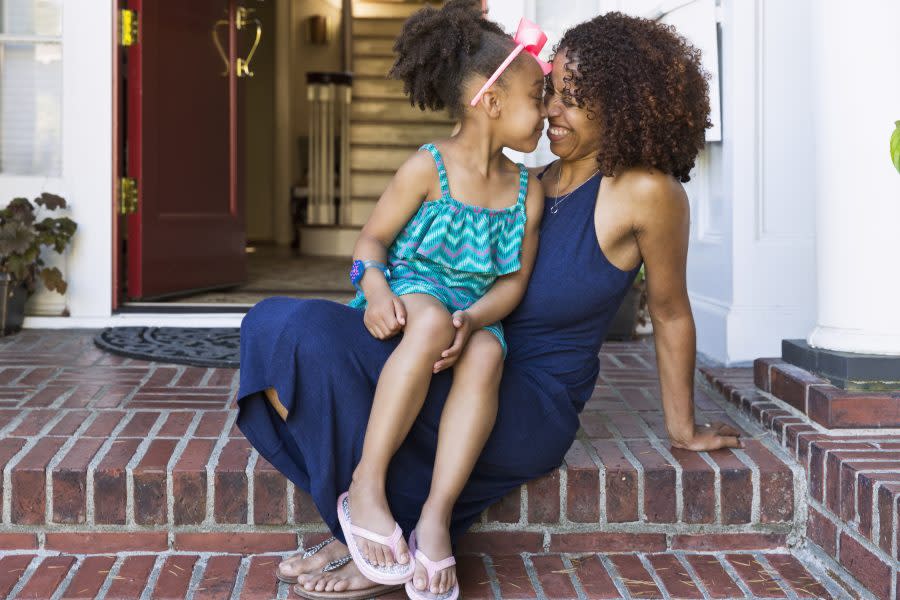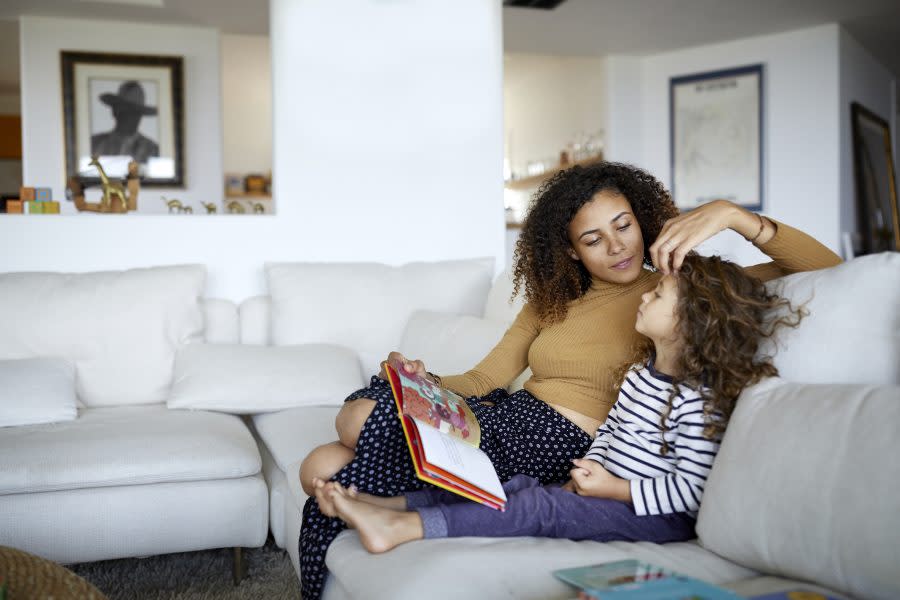Teaching my biracial daughters that all hair is good hair is an act of self-love
Originally posted on February, 8th, 2019.
There is an indeterminate amount of hope mixed in with the leave-in conditioner that I rub into my 3-year-old’s hair: Hope for her successful future; hope she will live a healthy life; hope that she will love her hair as it is. When I tenderly gather her moisturized hair into a ponytail, I often pause at the coarse patch in the back, remembering the ways my kinky and coarse hair was beaten into submission with heat and chemicals when I was a child. As I continue threading my daughter’s hair through the ponytail holder, I sometimes consider what it would be like to straighten her hair.
I become nauseated at the thought.
I am then taken back to memories from when I was her age, watching how the women around me dealt with their hair. They sat in the salon for four or five hours at a time to have their locks shellacked with the creamy crack—chemical relaxer—then braided, lengthened with weaves, or styled in updos, buns, ponytails, finger waves, bobs, and anything else they could imagine. Once my mother tired of straightening my hair with a hot comb in my grandmother’s kitchen, the smell of burnt hair and Sulphur 8 clinging to our noses for the rest of the day, I took my place alongside these women every other month on Saturday mornings.
I was six years old the first time my family’s longtime hairdresser applied chemical relaxer to my young tresses. I sat atop a stack of phone books trying not to scream as a violent burning spread across my scalp. Relief shook my body once our hairdresser washed away the relaxer, the water streaming an apology against my sore scalp. After my hair was pressed and styled, I couldn’t mess it up. Every strand had to stay in its proper place. I couldn’t play or swim in the water, sweat too hard, or touch my own head lest the straight hair revert to its natural state.
When my hair inevitably began to shrink, it was no longer pleasing; it was never able to retain its goodness for very long.
When I was growing up, every girl I knew wanted to have “good hair,” which was long and straight, easy to comb, or at least devoid of tight coils. Curly hair was not preferred, but the looser the curls, the better. Kinky hair was perceived as the worst. The concept of good hair is historically rooted in a time when Black people who had good hair likely had white heritage—often a consequence of slave masters raping their slaves. This gave birth to generations of white-passing Black people who sometimes took advantage of the privileges that their genetics provided them. As a result, good hair became correlated with a Black person’s social mobility, and this correlation continued into modern perceptions of Black hairstyles.

I saw this most on the playground when boys and girls asked lighter-skinned or silky-haired kids if they were mixed. If not, “then you must have Indian in your family.” The goodness in our hair was something so unattainable that it could never really belong to Black people. This concept proliferated through the Black community. No one I knew decried their blackness; however, there was a strong desire to change perceptions of Black hair through its manipulation.
Today, the average Black woman spends thousands on her hair each year. The money I spend on hair care for my daughters and myself is relatively small. I purchase economically priced products and accessories and I do all our styling at home; my girls are too young to go to a salon. However, the expectation to always present my daughters’ hair in a manner that is “good” weighs on me. It is tucked into our daily morning routine as I evenly part, brush, smooth, and clip my eldest daughter’s hair in preparation for preschool. These expectations greet me in strangers’ lingering glances at my children or when child care workers comment on the smell and style of my toddler’s hair. My husband, who is white, has negligible expectations about our daughters’ hair care since combing his bone straight hair has always been optional. “I defer to you,” he said. With that deference comes the weight of the world’s perceptions about black hair.
When I married my husband, the great hope for good hair lay in the words carefully spoken by both older white and Black relatives. They were tied to the praises for our not-yet-conceived children’s beautiful—but pointedly lighter than mine—skin. I was embracing my natural hair for the first time, 24 years after my first relaxer, and pregnant with my first child when my mother unloaded her concern on me. “I hope your daughter doesn’t have hair that gives you any trouble like y—.” My mother was trying not to express the trouble my own hair had given her. “I just hope her hair’s not too hard to comb.” She later texted me pictures of models with ambiguous ethnicities. The models always had long and voluminous hair full of waves or loose curls. I wondered what she would say if my daughter’s crown was tightly coiled like mine? Would it make hers any less good?
In these first three years of her life, my daughter has already had her hair “fixed” by other people. When she was one year old, I dropped her off at day care with a curly Afro and later picked her up with two slicked down, stiff ponytails. When I asked one of the older Black caregivers what happened, she responded, “I told them she didn’t need her hair fixed, but they didn’t listen to me.” She was referring to the white caregivers who supervised the nursery. I addressed the program director about the issue and received her full support. But occasionally, I would still pick my daughter up from day care with the blackness straightened out of her hair. Even my grandmother has questioned me about when I am going to “take a brush to” my daughter’s head. I responded that her hair is fine and that’s just the way it is, but she insists that it has to be styled different. “Hair fixing” is something Black children are all too familiar with. Our hair has earned us school detentions and suspensions. Even Black women have faced repercussions at work because of their hair styles. There is so much cultural rewiring—in and outside of the Black community—that has to be done.
Educating myself on natural hair helped me to unlearn much of the contempt for, and misconceptions about, my own 4C hair. Untangling the knotted ends meant untangling the comments from school kids who called it nappy or the hair dresser who said I “had that slave hair.”
As I bought various products and tried different styles to coax my transitioning hair to life, I learned how to tenderly care for it. I began to see it as an extension of myself that deserved to be loved.

When I look in the mirror at myself now, I sometimes get giddy at the progress I have made and the way my hair stretches and shines. I want nothing more than for my daughters to experience this now and not to have to wait two decades to find it.
The weekends my daughters will sit in the salon to have their hair professionally altered are far into the future. I want to first educate them about their hair. It’s important that they know how heat, chemicals, and certain styles impact their natural curls. I won’t push an agenda. They are free to have their hair relaxed, natural, braided, shaved off, or whatever they choose as long as it’s healthy. They have the right to make choices based on a greater love for their whole selves and not a need to conform to cultural expectations. How they style their hair will be an expression of who they already are. I know that their biracial heritage will afford them a privilege I never had. Their hair struggles will likely never be as difficult or as shameful as mine, because their hair falls into one of the good hair tropes: “the looser the curls, the better.” Nevertheless, educating them on the inherent goodness of their hair—because it is theirs and healthy, not because they are mixed—is important.
I consider these things when I style my eldest daughter’s hair. Thankfully my husband is willing to learn, and styles her hair as well. We try to maintain a regular routine each day. She sits in our lap before school while we spritz her hair with water and use our fingers to apply leave-in conditioner that caters to her curls. She is fascinated with ballerinas, so now her hair goes in a single “ballerina ponytail” with a tuft that I finger tease. I finish by adding a row of beaded heart-shaped clips to the back of her head. At night, I take down the ponytail to re-moisturize my daughter’s hair and gently massage her scalp. If she’s not too antsy, I divide her hair into six parts and twist it for the night to prevent knots. I try to explain step-by-step what I am doing to reduce ambiguity. I want her to be familiar with her hair in a way that I never was.
My words and gestures are intentionally measured when I style her hair. The language I use is positive so that the tangled, uncertain mess of my hair’s past won’t weave its way into the next generation. We often sit on the floor in front of my closet mirror so that she can see her hair as I style it. “Don’t worry about these knots,” I say. “If we’re patient, we’ll work them out so they don’t hurt us.” At this, she giggles and says, “Silly knots!” My husband and I sit our infant nearby so that she can watch too. She is only a few months old, but she stares intently, learning a little each day.
I let both my girls play with my hair so that they can learn about our three different hair textures. Sometimes I brush my Afro against their faces for a cheap giggle. Their laughter loosens the restrictions placed on my hair as a child. I also look them each in the eye—staring at myself in the mirror as well—and say, “We all have gorgeous hair.” With all of this, I make sure to teach them that no hair is better than others. That it is all beautiful in its many forms. And one day when we get past our hair being good hair, we will finally be able to just let our hair be hair. No qualifiers needed.

